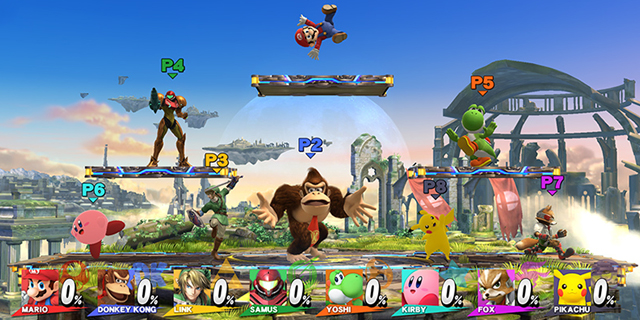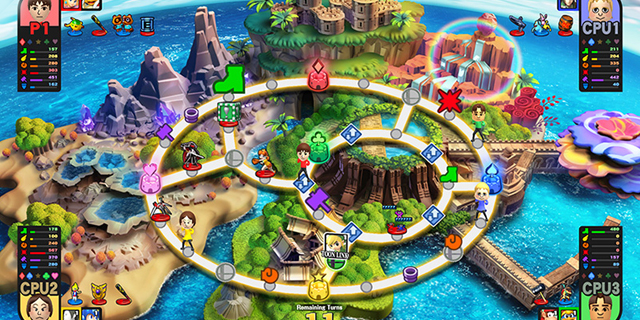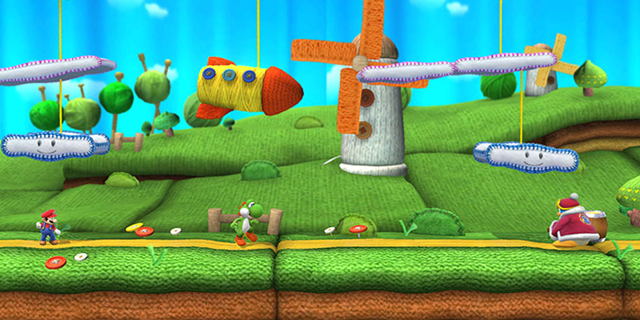
The premise of the original Super Smash Bros. on the N64 centered around the idea that Nintendo figures were drawn from a toy box, brought to life by Master Hand to duke it out on various battlefields. While the franchise hasn’t really been known for its lore, the concept itself has clearly defined the path the series has taken. Super Smash Bros. for Wii U, brought to life by Masahiro Sakurai and a team at Bandai Namco, feels even more like a collection of cool toys in a box than previous installments, eschewing any attempts at narrative and cohesion in favor of a menu full of disparate-but-entertaining options.
Those who have played the 3DS version of the game will inevitably feel at home here; the game was developed in parallel, and the mechanics, items and characters are seemingly identical. The stadium events, trophy options and other surrounding elements are intentionally repeated, and that leads to familiarity tinged with just a bit of redundancy. That doesn’t mean there isn’t anything new here — far from it. It just means that what’s new here really lies in the feature set, and only in the feature set.

A musical journey
Smash‘s soundtrack contains a wealth of Nintendo’s best music, and not just from common titles. Look closely, and you’ll see Soma Bringer, Glory of Heracles, Captain Rainbow, Dillon’s Rolling Western, Culdcept, Baten Kaitos Origins and more buried in stages’ track options.
The biggest advantage the game has over its portable brother lies in local multiplayer, and it leans into this wholeheartedly. Two-player co-op is available for any mode that can manage it, from the Classic Mode to Events and All-Star to Trophy Rush. Four-player support is even implemented in stadium modes now, for those who want a diversion.
The real bonuses, though, lie in the game’s two showcase modes. Smash Tour is a board game of sorts for four players, in which you’re tasked with moving about and collecting fighters and bonuses before a big end-game clash. It’s random and chaotic and won’t scratch the same itch as a real unplugged title, but it evokes the sort of feeling you had when you first started playing Mario Party without the fatigue that comes from too many plays taking way too long. Smash Tour can be wrapped up in a half-hour or less, even with the longest settings, and is a nice change of pace from just picking characters and stages over and over.
The other main new option is Eight-Player Smash, which is… well, what it sounds like. Players can use any combination of remotes, nunchuks, Classic Controllers, Pro Controllers, 3DS systems, GameCube controllers and even the GamePad to get up to the number of needed pads, and only stages really capable of managing large crowds are enabled here. It’s really this mode that makes the new Smash what it is, allowing for both insane, chaotic free-for-alls and the sort of strategic team contests and Amiibo battles that let you explore the full range of what Smash can do.

Disappointments
The seemingly ever-present lag when playing with strangers online isn’t the only misstep in the package. The Stage Builder is much more limited and difficult to use than Brawl‘s, and the shortened path to unlocking all the characters makes the feat seem like less of an accomplishment.
You may have noticed some mentions in there of some extra plastic that may be invading your living room. In addition to managing new GameCube controllers and adapters to use them with the Wii U (if you can find them), the new Smash is the first substantial use of the Amiibo figures. An Amiibo is a little buddy of sorts in the game, letting you train them and help them train you. Think of them as your own Apollo Creed. It’s too bad that you can’t play as a trained-up Amiibo, but this does allow them to become substantially better than a normal character, unlike the rest of the game’s custom fighters, which can only be equipped with modifications. Still, you can’t use Amiibo in all modes, so your capacity for fun with them may be limited.
Speaking of training, the easiest place to do that is online, and Super Smash Bros. for Wii U offers the same suite of modes found in the 3DS version. There are a few differences, though, most notably the often-more-stable connections offered on a home system. You can also head into free-for-all or team matches with a local friend. Still, we can’t help but feel like this could’ve been Nintendo’s opportunity to have a more fleshed-out online experience, and that’s just not the case. The best option here is to join some friends, as you can weed out those with bad connections and use the fun of friendly rivalry as a motivator.

More to come
Nintendo promises future updates for the game, and not just Mewtwo. The company plans sharing functionality for photos, fighters and stages, as well as an online-enabled version of the tournament function, which is noticeably absent from the initial release.
While the online offerings are rather sparse, there’s no shortage of variety offline, even for just one player. The events are back, offering special scenarios that are as amusing as they are fun to play. There’s a lot of incentive to dive into these challenges, as special stages and items can be unlocked here. Once you’re through these pre-made battles, it’s a good time to check out the two Special Orders options. These offer randomly-generated competitions with special twists and varying difficulty. Whether the one-off Master Orders battles or the push-your-luck Crazy Orders series of consecutive challenges is more your thing is up to you, but both build on this random setup and let you keep playing and unlocking without doing the same thing over and over.
Super Smash Bros. for Wii U is geared toward its role as a multiplayer showpiece, and it’s that context in which it shines, but it’s not lacking in content to try in the periods between game sessions. It’s a must-own for Nintendo fans, and if you own a Wii U, well, you’re probably in that category. It’s been a strong year for first-party releases on the platform, and Smash hangs with the best of them.
Pros: Eight-player modes, Smash Tour is fun, many modes made co-op
Cons: Lag is unavoidable online, Amiibo could’ve been more useful



















